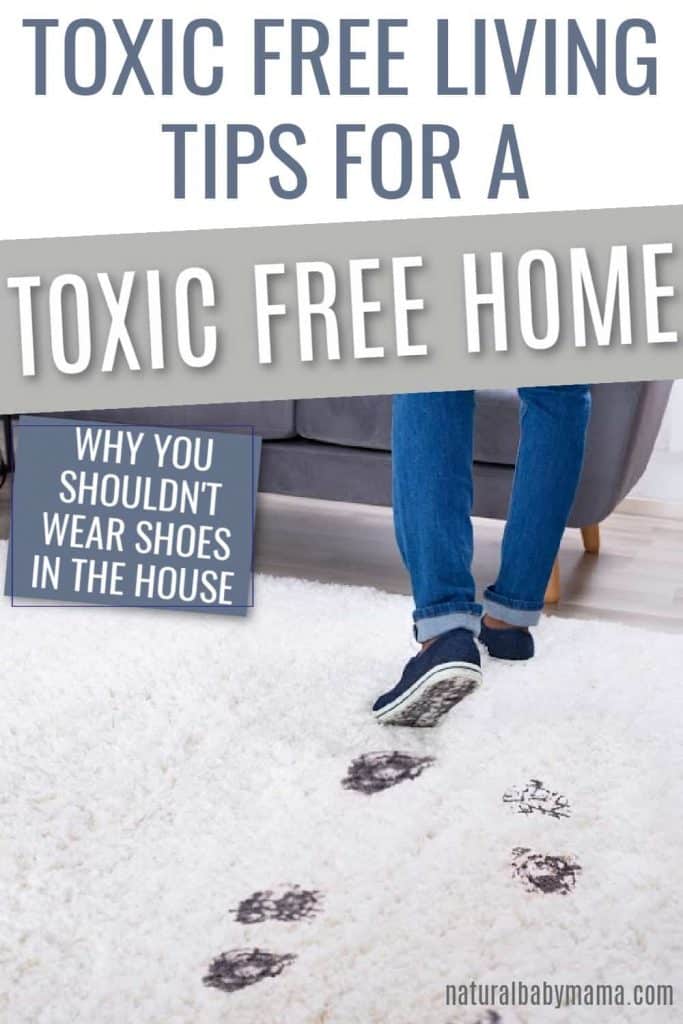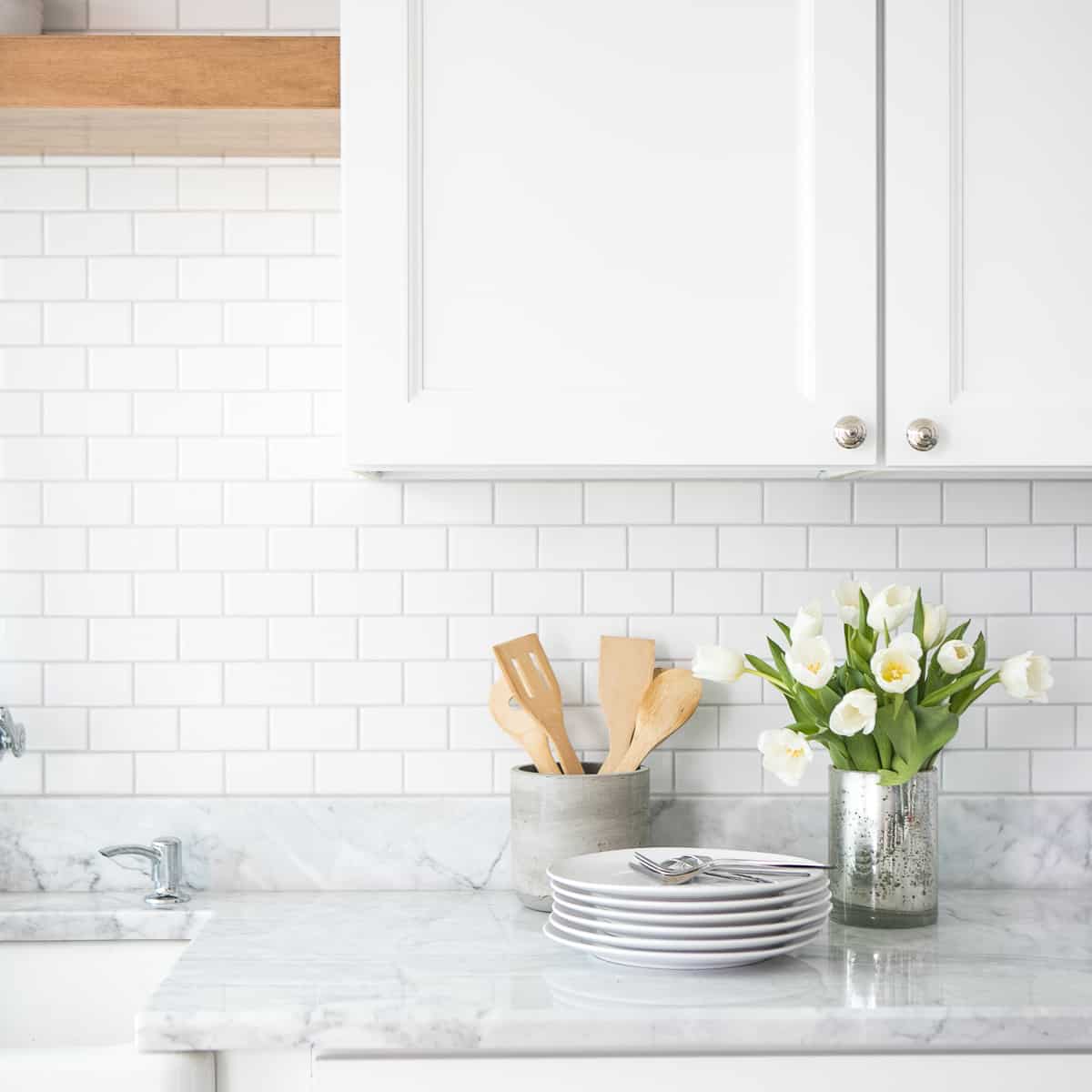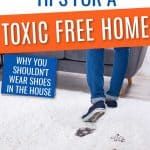Removing your shoes before coming inside is one of the essential things you should do for a healthy, non-toxic home. Going to a shoe-free home is so easy once you realize the number of toxins and bacteria that are on the bottom of your shoes. Let’s jump into why you shouldn’t wear shoes inside the house.
This post may contain affiliate links. Please see my full disclosure policy for details.
Scientists have been studying the bacteria that live on the soles of your shoes for decades. They have discovered a diverse microbiome of germs, bacteria, and toxins that could make you and your family sick.
Over 50% of people leave their shoes on some of the time while at home. Over 80% of people don’t ask guests to remove their shoes before stepping inside the house.
Home is where your family congregates. Kids playing on the kitchen floor or toddlers crawling around the room are exposed to toxins that are carried in on the soles of shoes.
We don’t wear shoes inside the house, and I’ll discuss below you why you shouldn’t either. Plus I’ll give you some tips for making the transition easier.
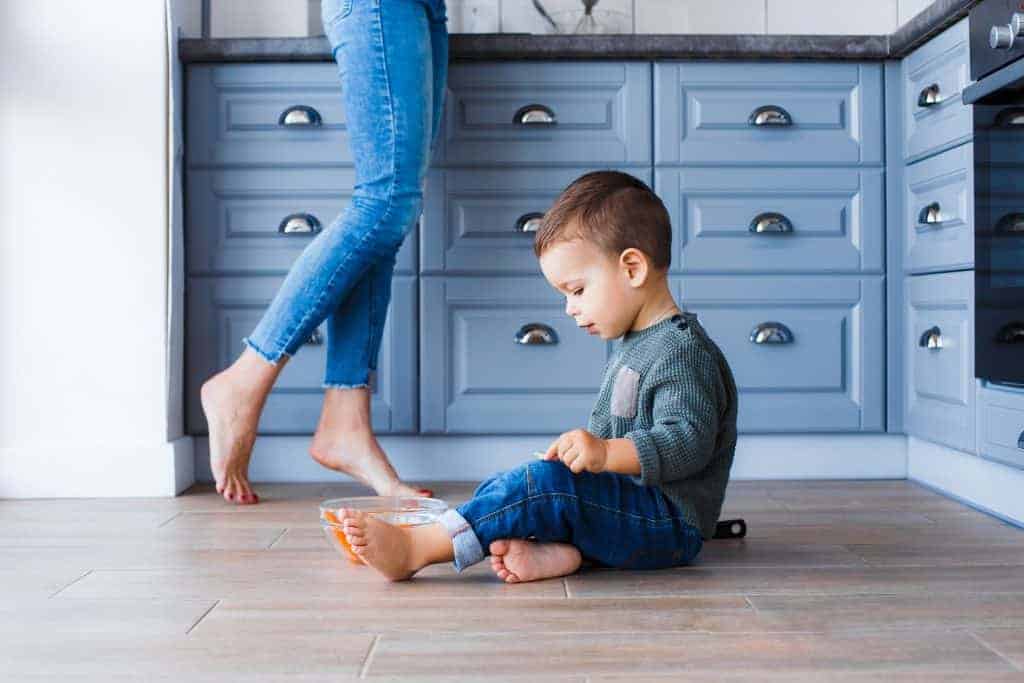
Quick Navigation
Why is Wearing Shoes Inside Harmful?
Walking through public restrooms, parking lots, grass that has been sprayed with pesticides, and heavy foot traffic areas is a daily occurrence for most of us. While doing this, we pick up many dirty culprits that follow us from place to place – including our home.
A study conducted at the University of Arizona by microbiologist Dr. Charles Gerba measured the number of bacteria present on the bottom of new shoes after a two week period.
This study counted over 400,000 units of bacteria on the outside of shoes and another 2,800 units of bacteria on the inside.
The number one bacteria found on shoes was E Coli, likely picked up from public restrooms and animal feces outside.
Dr. Gerba also discussed how bacteria like E Coli can be carried over a long period of time, and tracked into your home.
Every member of the family can be exposed to these toxins and bacteria – especially kids. Infants and small children are especially at risk of contracting illnesses from the germs tracked in on shoes. Our children are playing on our floors, we want to make sure they aren’t playing on a floor filled with toxins and bacteria.
Exposure to harmful toxins and bacteria can increase the likelihood of sickness in your home for every family member. Understanding the risk is the first step in negating this.
Toxins Living on Your Shoes
Like E Coli, a number of different bacteria and toxins can live on the soles of your shoes. Some of these toxins can cause illness and even cancer. The list below breaks down the most common bacteria and toxins you could be carrying around right now.
E Coli
Escherichia Coli or E Coli is a strain of bacteria that lives in our guts and the guts of some animals. Some E Coli is necessary for a healthy gut, but coming in contact with other strains can make you sick.
E Coli is typically associated with diarrhea, but it can also cause urinary tract infections, meningitis, pneumonia, and other infections that affect the respiratory system, bloodstream, and the healing of wounds.
One especially bad strain of E Coli, known as O157:H7 is the leading cause of kidney failure in children. It can cause stomach cramps, bloody diarrhea, and vomiting.
E Coli is the number one bacteria found on shoes, and it’s impossible to avoid. We pick up E Coli from public restrooms and animal feces outside, making the bottom of your shoes as dirty as a toilet bowl.
C. Diff
Clostridium Difficile or C. Diff is a bacteria that can cause diarrhea and inflammation of the colon. If untreated, it can become life-threatening. Dr. Jahangir Alam discusses the spread of C. Diff during the annual meeting of the American Society for Microbiology, stating our shoes are a leading culprit of spreading this disease.
C. Diff is known to live predominantly in health care facilities and hospitals, but recent research suggests C Diff. is transmitted from hospitals, out to the community, and back to hospitals via our shoes.
Dr. Alma and The University of Houston College of Pharmacy collected thousands of samples in Texas to understand how C Diff. is spread throughout the community. They discovered C Diff on 26% of shoe samples. This is more than 13% of frequently touched hospital surfaces.
Of the 26% positive C Diff. shoe samples, toxigenic strains of C Diff were found on 63%. Dr. Alma discussed how hospitals are disinfected regularly, but our shoes are not.
Pesticides & Herbicides
Bacteria isn’t the only thing you have to worry about tracking into your home. Pesticides and herbicides are also a concern.
A study conducted by the EPA’s National Exposure Research Laboratory found that pesticides and herbicides can be tracked into the home up to a week after treating your yard. The study found carpeted rooms held the highest amount of contaminants throughout the house.
When you, your kids, or your dog walk through neighborhood lawns or parks, you have no idea when or if they treated their lawn with pesticides.
Exposure to pesticides and herbicides can have immediate to long term effects for people. Short term effects can include burning of the skin and eyes, nausea, dizziness, vomiting, diarrhea, and more.
Long term effects include reproductive harm, birth defects, cancer, and even death. Some people are more susceptible to harmful side effects such as children and the immunocompromised.
Other Toxins
While pesticides and bacteria are most commonly found on the bottom of shoes, other harmful toxins can be present, as well. Since our shoes make contact with the ground outside, the likelihood of exposure to the following is high:
- gas
- oil
- asphalt and coal-tar sealed pavement
- fertilizer runoff
When it rains, many of these toxins gather on sidewalks, streets, and parking lots. These areas are impossible to avoid, so remaining diligent about keeping shoes out of the house is key to prioritizing the health of your home.
In addition, if you walked through an area with lead paint chips or lead dust that could be tracked on the bottom of your shoes as well.
Another Benefit – Less Dirt
Another great benefit of taking your shoes off before coming inside is a cleaner home. I’m all for kids getting messy and playing in the dirt outside. I just like to keep it outside! Taking off shoes before coming inside helps keep the dirt inside your home down.
Less dirt and debris that are tracked inside means less cleaning for you. I would call this a win-win situation!
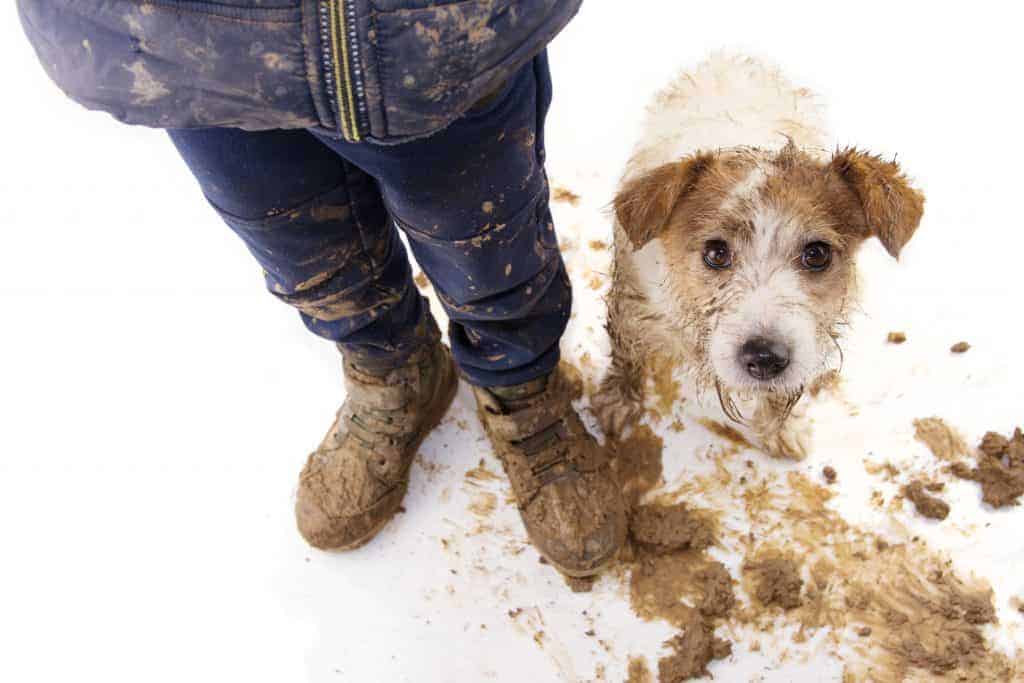
Where to Put Shoes
The research is hard to ignore when it comes to wearing shoes inside the house. To keep toxins out, keep your shoes outside of your home.
Placing shoe racks or bins next to the doorway is a good place to start. I take off my shoes outside the door and carry them in to decrease the chance of contaminating our home. We also have shoe racks outside our front door for the shoes we wear the most often.
It’s important to make sure kids and other family members understand where to put shoes before stepping inside. Having a shoe rack or bin right inside the door is the easiest way to keep everyone on track.
Placing a washable rug under your indoor shoe rack is a great, easy way to keep that area clean. In our home, we have several types of shoe racks. I really like these stackable bins from IKEA. We also have more traditional metal shoe racks.
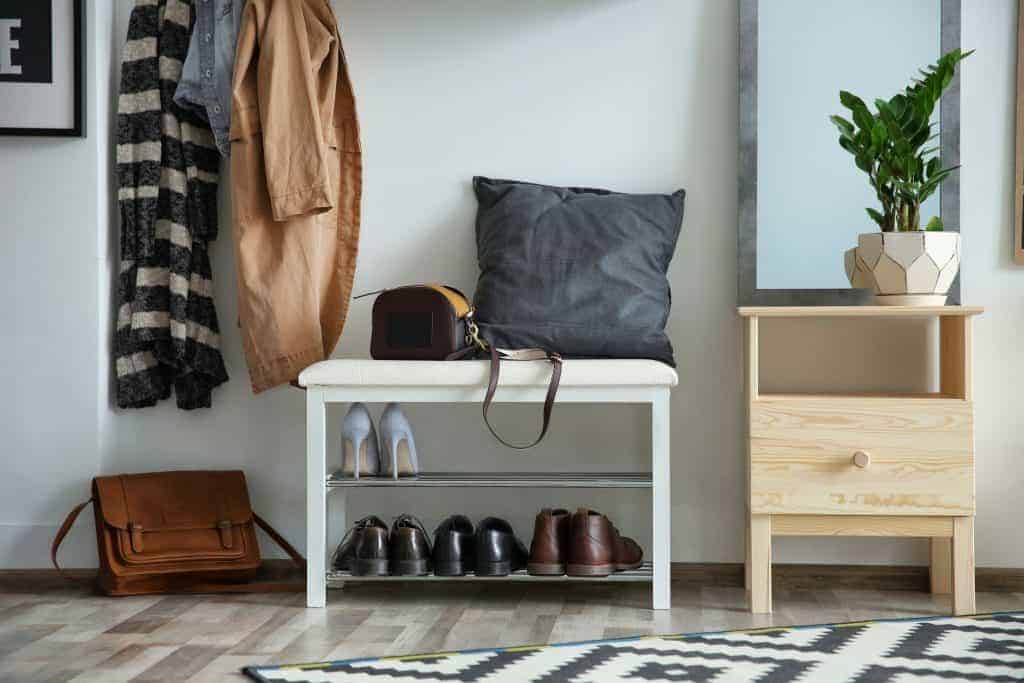
Since pets don’t wear shoes, it’s important to keep them away from treated lawns. Consider keeping wipes by the door to clean dirty paws. We use a towel to wipe off our dog’s paws when he comes in. Pairing this with frequent baths will reduce the number of germs your pet brings in.
How to Handle Guest’s Shoes
Hosting family and friends can be incredibly rewarding, but inviting guests also invites the bacteria and toxins they carry on the bottom of their shoes. You can still enjoy time with those you love without worrying about contaminating your home.
Most people are open to removing shoes inside the house. Communicating with guests who haven’t been to your home prior to their arrival is key to ensuring no shoes inside the house. Let them know you are a shoe-free house and explain your shoe system to minimize confusion. I often just say, we don’t wear shoes in our house when you come over do you mind taking your shoes off outside before coming in?
Some guests may prefer not to go barefoot. You can provide slippers or comfy socks for them to wear instead. You may want to keep a stock of plush socks or slippers in multiple sizes to make sure you’re prepared.
Some guests, such as the elderly, may not be able to remove their shoes. In this case, we like to keep workers’ booties around to slip over their shoes.
You can easily breach the topic of removing shoes inside the house by hanging a sign on the front porch or purchasing a welcome mat that cleverly displays the rule. I also find that when answering the door it’s helpful if I stand in the doorway and politely remind people to remove their shoes if they haven’t already.
Final Thoughts
The amount of harmful bacteria and toxins we carry on the bottom of our shoes is staggering (and gross!). Wearing shoes inside the house can increase exposure to harmful bacteria such as E Coli and C Diff. It can also increase the amounts of toxins, pesticides, and herbicides in your home.
Long term exposure to toxins and bacteria can make your family sick and expose your family to unwanted toxins. Especially infants and young children. Removing your shoes inside the house is such an easy way to keep a safe, healthy, and toxin-free home.
Having a designated space for shoes will help keep your family and visitors from wearing shoes inside the house. Providing shoe alternatives will help keep guests comfortable while maintaining peace of mind that your home is toxin-free.
Pin it for later!
